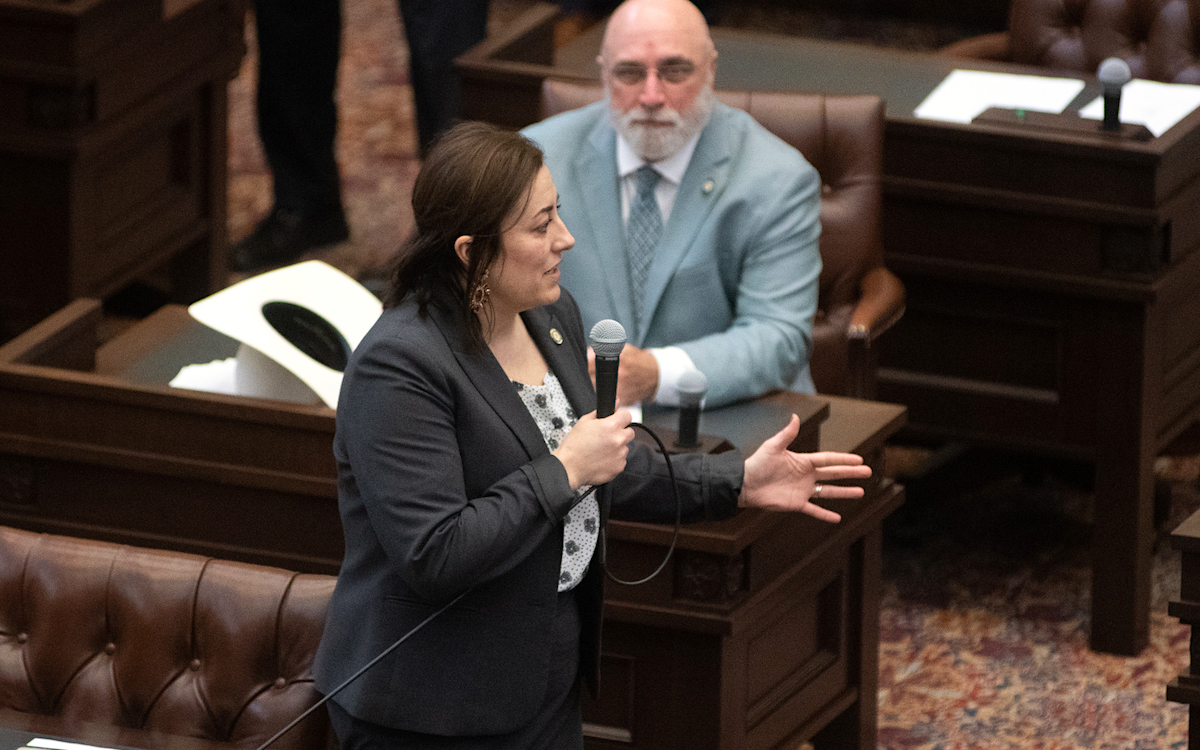

Sen. Jessica Garvin (R-Duncan) says she is not trying to be a buzzkill with legislation like SB 440, would cap the potency of medical cannabis products. Her bill, and others, come at a time when the 2023 legislative session coincides with the SQ 820 election to decide whether Oklahoma will legalize cannabis for adult recreational use on March 7.
There are about 50 bills in the House and Senate this session that involve medical marijuana. They range from HB 1734, which would require dispensaries to display signage about the risk of consuming cannabis while pregnant, to SB 116‘s proposal to keep cannabis grow operations away from churches.
But few have garnered the attention SB 440 has. That bill, if passed, would set limits on THC potency for all cannabis products. Cannabis flower products would be capped at 30 percent, with a 60 percent cap for the distillates that are commonly used in vape pens. Currently, distillates in vape pens are commonly higher than 80 percent and can exceed 90 percent potency in some cases.
Garvin said, in the past, cannabis legislation had not been something that interested her, though she has seen the benefits. She said her dad, who is a physician, had a patient that used CBD and cannabis products with THC to treat some of the side effects of his cerebral palsy with success.
“Just seeing that made me a believer,” she said.
Garvin said she has enjoyed working with and getting to know those in the cannabis industry, although last year Garvin authored a bill that ultimately increased certain licensure fees, and it led to a threatening voicemail from a license-holder in eastern Oklahoma.
This year, Garvin has again heard from those who are opposed to one of her bills. She said the potency cap legislation is not an attempt to water down cannabis-related products solely for the sake of doing so.
“One of the most important things to understand is that the cannabis that’s grown today is different from what we saw in the ’60s and ’70s and even the ’80s when it comes to how strong it is,” she said. “I’ve read a lot of research about potency and cannabis use and how high levels of THC can impact your brain. That research shows that using cannabis products with high levels of THC for long periods of time can cause mental health problems that can range from psychosis to schizophrenia to higher suicide rates.”
Several states have explored the idea of limiting the potency of cannabis products, including Washington, Montana, Massachusetts, and Florida. Vermont’s Legislature has debated removing its caps on recreational cannabis products, which limit flower to 30 percent and distillates to 60 percent.
Concern over the impact of long-term use

Garvin’s potency bill advanced unanimously from a Senate committee last week, although the bill’s title was struck, which is a procedural measure used to guarantee additional consideration of controversial measures.
Garvin said she does not oppose the use of marijuana for medical purposes or the state’s medical marijuana program as a whole. She does believe there has been little consideration of what she thinks can be the long-term impact of use.
“I’m not trying to limit it because I hate the industry or the people involved in it,” she said. “I’m concerned about the long-term impact of high-potency THC and the negative impact on a person’s brain. We have a huge gap in mental health services in Oklahoma. The last thing we need is people with more mental health problems. I’m not anti-industry, but we have got to get a handle on how strong some of these products are.”
Garvin said if SQ 820 passes, she would be in favor of capping recreationally available cannabis potency at 7 to 10 percent THC regardless of the type of product being used.
“Going back to what I said about how cannabis was back in the ’60s and ’70s, that’s about how potent it was: 7 to 10 percent,” she said. “So, from my view, that’s a pretty good place to start.”
Garvin said among her other concerns are high school students who have medical cards and who use those products at school or who give them to friends to use. She said this issue has come up more frequently in recent years since the state’s medical program started.
“I’ve had superintendents tell me that they’ve seen more kids coming to school in a state of mind where they can’t learn,” she said. “These kids have access to the highest levels of potency, and nobody really seems to care. Their parents are letting them have cards or may not know they have one. I’ve had dispensary owners tell me they come in and want whatever they can to get as high as possible. I don’t know how we can expect kids to get a great education under those circumstances. Their brains don’t even finish developing until they’re 25.”
‘It would probably do exactly the opposite’
Former Rep. Mike Ervin (D/R-Wewoka) is now a board member of the Oklahoma Cannabis Industry Association. He said potency limits like Garvin’s could be problematic in their own way.
“I know that it is an issue that is brought forward by well-meaning legislators, and it sounds on its surface like a really good idea that would increase safety,” he said. “But my perspective is that it would probably do exactly the opposite.”
Ervin said that even if THC potency were capped for various products, most cannabis consumers would likely up their own dosage to achieve the same desired effect level.
“You have one product that is 90 percent potency, but it takes 200 doses in order to deliver that 0.9 grams. That product would not be compliant under that scenario,” Ervin said. “However, you have another product that has exactly the same amount of THC but is encapsulated in something that is three times or four times heavier that is not THC, making it compliant according to the law. And yet, that product can deliver that 0.9 grams in one dose. So, the safer product would be non-compliant, and the less-safe product would be compliant. I understand the thinking behind it, and it does seem to make sense until you actually know how the industry operates and what those products are and how they deliver those doses.”
Rep. Scott Fetgatter (R-Okmulgee), who has worked on a number of cannabis-related bills since the state’s medical program started four years ago, said he does not understand the timing of Garvin’s bill.
“I would like to understand better why the author — at this point in the grand scheme of the marijuana industry, nearly five years in — wants to make this change, which changes the entire business model,” Fetgatter said.
Attorney Ryan Kiesel, who has worked on the SQ 820 campaign as an adviser, said ideas like Garvin’s are to be expected as the state’s marijuana industry continues to grow and mature.
“This is a new industry in the state of Oklahoma, and it has become an incredibly important industry,” he said. “[The industry] has created jobs in every town, large and small, across our state with a lot of revenue already. But the fact remains it is a new industry, and like any new industry lawmakers are going to be responding to it. We’re always going to have folks that are well-intentioned, even if they’re off the mark trying to push legislation.”
Under Garvin’s bill, the Oklahoma Medical Marijuana Authority director would be tasked with setting and enforcing THC limits on products. OMMA director Adria Berry said that task would be fairly easy for the agency.
“There are other states with medical-only programs who have [potency limits], so it’s not unusual to see that,” Berry said. “From our perspective, we would simply add that to our software program to make sure it’s being capped by Metrc. It would all be done at the lab level.”
Other cannabis bills this session

Fetgatter has filed several cannabis-related bills this session, including one that would essentially be a re-boot of the state’s seed-to-sale tracking system. Seed-to-sale tracks plants across their lifespan beginning when they have been planted as seeds and ending when they are turned into products sold at dispensaries. Metrc is the state’s current vendor for the program. Fetgatter’s HB 1347 would require OMMA to issue a request for proposal that could spur the finding of a new vendor.
“The reason for 1347 is because there has been a lot of bad communication with the industry, and it has caused some of our Oklahoma businesses who are trying to work legally within the confines of the law great distress,” Fetgatter said. “I was vocal about seed-to-sale not fixing the black market. It’s a tool that we can use to help, but it won’t fix it on its own, and I think that’s been proven since we have so much black-market activity in Oklahoma right now.”
Garvin also has SB 439, which would require physicians to see patients in person when considering whether to prescribe medical licenses. That would mean virtual appointments offered by doctors in the area would be prohibited in most cases. Often, physicians who market themselves for the purpose of authorizing medical marijuana applications see patients for only a matter of minutes, and many do so over the internet.
“To be clear, I’m 100 percent in favor of telemedicine,” she said. “I just think it’s not ideal when these doctors approve licenses without ever having seen their patient in person. These doctors are supposed to be taking care of their patients but there’s never any follow-up on how they’re doing.”
SB 801 by Sen. Bill Coleman (R-Ponca City) would give municipalities more control over allowing marijuana grow operations within their city limits. The bill would allow cities and towns to modify their standard planning and zoning procedures to forbid certain zones from being used for marijuana operations.
The OMMA website features a page that chronicles the movements of 2023 marijuana measures in the Oklahoma Legislature.




















